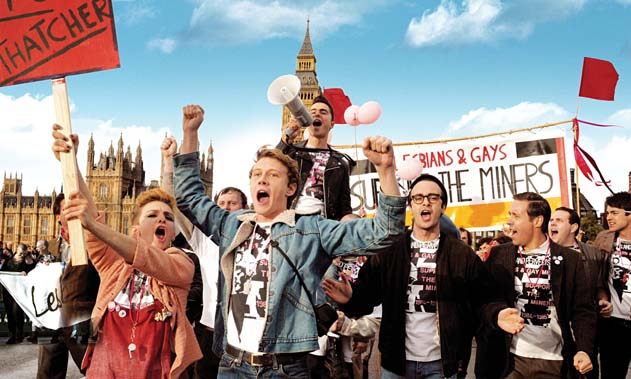Pride is the brilliant and true story of Lesbians and Gays Support the Miners (LGSM), a solidarity group set up to raise money for British miners during their historic strike of 1984-1985.
You might think it’s an unlikely alliance—predominantly male, stereotypically masculine workers lining up with gay men and lesbians in the era of homophobic hysteria about AIDS? And yet common opposition to PM Margaret Thatcher, the police and the tabloids created a natural compulsion towards solidarity between miners and LGSM.
“One isn’t here to be a softie”, says a plainly-evil looking Thatcher in Pride’s opening scene. She and the British ruling class had set out to destroy working class resistance in the UK and were determined to stare down the miners, closing a large number of pits across the country.
For a year the miners fought with courage against police violence and poverty without the support of other unions. Thatcher was the ultimate winner, but those who fought finished the strike as different people.
Rosa Luxemburg once said that the transformation of our class during strikes was “the most precious thing, because it is the most enduring.”
LGSM raised the most money of any support group during the strike, but the political connections lived on much longer. It was the deciding vote of the NUM that won the UK Labour party to supporting lesbian and gay rights.
Sian James, then a miner’s wife in the small Welsh village portrayed in Pride, explained in a recent interview how the solidarity was built: “the common thread was it was a group of people telling us they had been oppressed for many years … We discovered quickly we had more similarities [than differences].” One member of LGSM even criticised Pride for making it seem like the miners were less supportive than they were in real life!
The miners’ strike is a lesson in the way struggle provides an opening to challenge ideas and prejudices. It’s all there—Sian, for instance, someone who saw herself and was seen as primarily a miner’s wife, is thrust by the force of circumstances into the frontlines of the political battle in the strike support committee, fighting with and breaking down sexist ideas while doing so. Meanwhile the miners build their own confidence while their political horizons expand, and others still gain confidence to come out.
When LGSM is attacked by The Sun newspaper, who decries the alliance between “Pits and Perverts”, Bill Nighy’s character, Cliff, a former miner, sees through the nonsense, arguing with his sister, “I don’t believe what they write about us [the miners], so why should I believe what they write about them?”
In a quote that typifies the impact of the solidarity, a miner tells the irreverently named “Pits and Perverts” Ball that, “Now we will pin your badge on us, we will support you. It won’t change overnight, but now 140,000 miners know that there are other causes and other problems. We know about blacks, and gays, and nuclear disarmament. And we will never be the same.”
Working class struggle
There are two take-away messages from Pride.
The first is that there is a connection between the struggle against gay oppression and the struggle of the working class against capitalism. LGSM is part of a long history that begins with the first revolutionary wave of the 20th century. While Australian politicians still declare their allegiance to “traditional marriage”, nearly 100 years ago in revolutionary Russia, the Bolsheviks sanctioned a marriage between two women not long after they had decriminalised homosexuality (by comparison, NSW decriminalised homosexuality in 1984). German socialists formed history’s first gay rights organisation, organising the First Congress for Social Reform in 1921.
The Gay Liberation movement emerged from the revolts of 1968—we had our own version of Pride when in 1973 hundreds of workers from the Builders Labourers Federation (BLF) stopped work on a construction site at Macquarie University for a gay student who had been expelled from his college.
One fact that Pride neglects to mention—apparently to make it more palatable to an American audience—is that Mark Ashton, the magnetic activist at the centre of LGSM, was a member of the Young Communist League and other members were Trotskyists and/or Gay Liberation movement activists.
The other lesson is the ineffectiveness of identity politics. In the film (and in real life) a small group of lesbians split off from LGSM to form Lesbians against Pit Closures. It’s obvious in the story that their move is based on abstract principle, not sensible political strategy—they decide to divide precisely at the moment that homophobia and sexism is being broken down. LGSM itself was a gay only group, yet their open, political approach wins while separatism wallows.
A mainstream film as good as Pride doesn’t come along that often—it’s one to see on the big screen.
By Amy Thomas
Pride
Directed by Matthew Warchus
In selected cinemas now






